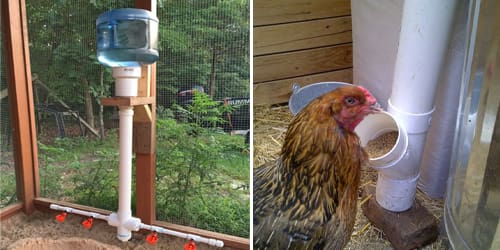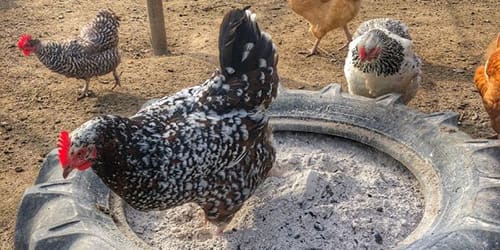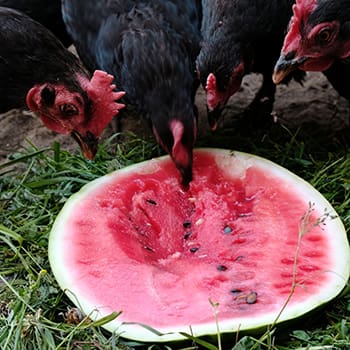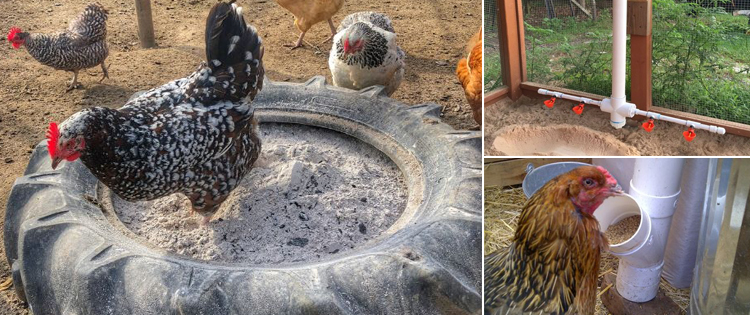Chickens are some of the best introductory animals to homesteading available in today’s market. You can find them on hundreds of websites, get them in the mail as chicks or eggs, and make fast friends with them if you want to be pals with your poultry. Today, we’ll take a look at a few easy ideas to make poultry care easier!
Feeders and Waterers
For feeding and watering your birds, I strongly recommend going and grabbing two 5-gallon buckets from your local hardware store. For watering, get coop cups and drill them into the very bottom edge (not underneath) of the 5-gallon bucket. You can then hang this at head height for the birds so the water stays clean or place them up off the ground.
The other 5-gallon bucket will be your feeder. Clip the bucket via its handle to the wall of the coop with a carabiner. Using a hole saw, cut a hole for a 90″ white PVC plumbing elbow. Fit the plumbing elbow into the hole and trim the inner, bottom edge of the elbow with a reciprocating saw. You can offer 5 full gallons of feed to your birds at once this way and it seriously cuts down on them throwing it everywhere.
Remember to put the lids on to prevent the water from getting mucky or the food from spoiling!

Keeping the Coop Clean
The deep litter method is always preferred for small homestead coops. Throughout the colder months, spread a little lime on top of your filthy bedding and cover it with at least 2″ of fresh bedding on top of it. When the world warms up again, go ahead and scoop out the entire coop and lay fresh straw, hay, or shavings down.
In warmer months, using a little fine gravel underneath the bedding is a great idea. It helps your birds find stones to eat for their crops and it offers drainage for the heavy summer rains (if you have those).
Related: Do you know why you should never put a tall fence around your house? (Video)
Dusty Birds
Unless you keep waterfowl, you know that birds aren’t a big fan of getting a bath. That is, a bath as we’d consider one. They prefer a dust bath.
The question is, how do you keep your dust in the coop? And how do you make sure they have enough access to it?
I recommend going and getting a big 50-pound bag of play sand. This is usually very clean sand and is easily available at your local hardware store. Even better, it’s usually pretty cheap. We dig out an area in the coop that is well covered and give them a sandpit to play in. This helps them clean up, keeps lice off of them (the dust from the sand cuts and smothers the lice), and it gives the birds something fun to do.
Do you have bantams? These birds may benefit from a small tray like a chinchilla would use. You can get chinchilla dust on thousands of websites and this performs the same function for these tiny birds. While they can use sand, too, it may be beneficial to use something like chinchilla dust for them. Sand is a little grainier than chinchilla dust and may irritate bantam birds’ respiratory tracts.

Enrichment for Enclosed Chickens
Keeping contained birds entertained is a pretty easy task, but we thought we’d see if we could give you a few new ideas:
Offer chickens live mealworms or crickets in paper towel rolls stuffed with hay, grass clippings, or straw. Don’t cram it in so tight that you hurt the prey bugs, but make sure that they can’t just run out of there. You may offer a few small holes for the birds to peek in and eye the insects.
Give them your scraps! You’d be surprised how much chickens appreciate a little meat attached to a T-bone steak or the remains of your pork barbeque. Unlike dogs, your chickens are unlikely to have any allergic response to the vast majority of foods you can feed them. We don’t recommend chocolate or a plethora of garlic, but most birds hardly notice either of those, too. Plus, chickens will get calcium and trace minerals from the bones. Just make sure that pets can’t get to the cooked bones, too.
I set up a small musical area for our birds. Use brightly colored children’s toys such as children’s mini xylophones to encourage your poultry to start up a little band. They like the colors and are attracted to tap them with their beaks or scratch them with their feet. The sounds intrigue them and you’ll find out which chickens have a musical heart within your flock!
Finally, I love finding old fish traps with large holes and stuffing them full of vivid fruits and vegetables, then hanging them overhead so the birds can peck at them all day long. Some birds may even jump up on top of the device and try to pry the lid off!
Weathering the Storm
Cold weather offers a distinct challenge if you want to keep your birds laying and cozy warm. If you live in an area where snow is frequent, as mentioned before, the deep litter method is a necessity. You can also add a color-change LED to their nesting box area. This allows the birds to enjoy a variety of colors throughout the evening (we recommend red during the evening and bright white during the day) as well as gives them a little extra warmth.
However, if you’re coming into summer you’re facing a completely different challenge. As mentioned above, try to keep your bedding light and airy. I don’t recommend offering your chickens fans since the wind gusts can cause respiratory issues, but there are other ways of keeping your birds cool. Freeze 2-liter (or larger) soda bottles full of water and place them around the coop. This allows birds to snuggle up to them to chill out when the heat is at its height. You can also add ice cubes directly to their water source, though these may melt pretty quickly in extreme temperatures.
Since chickens don’t appreciate being doused with water, I usually freeze cucumbers or bananas and toss them into the coop during the hottest part of the day. Not only does this impart important electrolytes and minerals, but the chill will last as it works its way through their digestive system and gives them a chance to get rid of some of that heat.
Final Thought
Remember, chickens are pretty weather-resistant and if your animals seem lethargic, I recommend taking them to your local veterinarian.
Have other neat ideas? We’d love to hear about them.
You may also like:
Chicken Secrets Nobody Told You About
How to Butcher Game and Livestock (Video)
36 PVC DIY Projects for Your Homestead
10 Common Mistakes You Should Avoid If You Want To Raise Chickens







